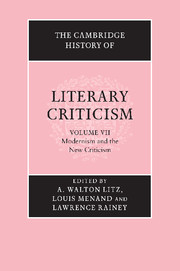10 - William Empson
from THE NEW CRITICS
Published online by Cambridge University Press: 28 March 2008
Summary
Do words make up the majesty
Of man, and his justice
Between the stones and the void?
Geoffrey Hill, ‘Three Baroque Meditations’William Empson's first book, Seven Types of Ambiguity, begun while he was an undergraduate at Cambridge, was published in 1930, when he was twenty-four. It established him at once and permanently as one of the two most brilliant practitioners of what he called verbal analysis, more commonly known as close reading. Only R. P. Blackmur had equal (if differently angled) gifts, and the two men were often grouped together as the critics who, as Stanley Edgar Hyman said, ‘did the work’ of intricate literary exploration, where others had preached or proposed it.
‘Close reading’ is a familiar phrase now, but we need to pause over it for a moment, since its implications have shifted rather drastically over the years, as those of catchphrases often do. I. A. Richards, Empson's teacher at Cambridge, later said his former pupil's ‘minute examinations … raised the standards of ambition and achievement in a difficult and very hazardous art’. The art was reading, and Richards himself had discovered (and reported in Practical Criticism (1929)) how inattentive and prejudiced even apparently serious reading could be. Close reading was rigorous reading, the opposite of loose or distant or offhand appreciation or criticism, and its appetite for detail produced many surprises. It was meant to complement historical knowledge, indeed might be said itself to offer historical knowledge, since the behaviour of words is an aspect of social life. Close reading then became a major instrument of the New Criticism, and the technique gradually came to suggest, in the minds of its detractors and sometimes even in the minds of its proponents, a concentration on the text to the exclusion of all context, as if words in literature had a separate, exclusive, self-contained life.
- Type
- Chapter
- Information
- The Cambridge History of Literary Criticism , pp. 219 - 234Publisher: Cambridge University PressPrint publication year: 2000



